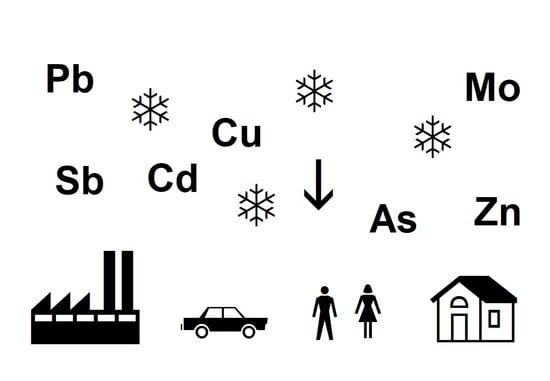Concentrations of Major and Trace Elements within the Snowpack of Tyumen, Russia
Abstract
1. Introduction
- To identify the basic distribution of the major and trace elements of snow,
- To evaluate the ratios of particulate and dissolved forms of TMMs,
- To assess the ecological risks associated with TMMs pollution of the atmosphere.
2. Materials and Methods
2.1. Study Area and Sampling
2.2. Sample Collection
- (1)
- The historical center with buildings that have existed since the 17th century and are now used by social and administrative organizations;
- (2)
- Low-rise residential area that have existed since the 19th century;
- (3)
- High-rise residential area that have been constructed within a period from the 1950s to the present time and that now house the major part of the Tyumen population;
- (4)
- Modern business zones;
- (5)
- Industrial zones;
- (6)
- Transport zones affected by road traffic (located between main roads and buildings of various usage). Sampling within transport zones was carried out at distances of more than 15 m from roads in order to exclude direct contamination by road dust. The sampled snowpack was visibly undisturbed by any human activity.
2.3. Analytical Procedures
2.4. Calculations and Data Analysis
3. Results and Discussion
3.1. Salinity, pH, and Dust Content
3.2. Elemental Composition
3.3. Contamination Levels and Risk Assessment
3.4. Comparison of TMMs Concentration with Other Data
4. Conclusions
Supplementary Materials
Author Contributions
Funding
Data Availability Statement
Acknowledgments
Conflicts of Interest
References
- Kasimov, N.S.; Vlasov, D. Global and Regional Geochemical Indexes of Production of Chemical Elements. Geogr. Environ. Sustain. 2014, 7, 52–65. [Google Scholar] [CrossRef][Green Version]
- Pacyna, J.M.; Pacyna, E.G. An assessment of global and regional emissions of trace metals to the atmosphere from anthropogenic sources worldwide. Environ. Rev. 2001, 9, 269–298. [Google Scholar] [CrossRef]
- Zhulidov, A.V.; Robarts, R.D.; Pavlov, D.F.; Kämäri, J.; Gurtovaya, T.Y.; Meriläinen, J.J.; Pospelov, I.N. Long-term changes of heavy metal and sulphur concentrations in ecosystems of the Taymyr Peninsula (Russian Federation) North of the Norilsk Industrial Complex. Environ. Monit. Assess. 2011, 181, 539–553. [Google Scholar] [CrossRef]
- Äyräs, M.; De Caritat, P.; Chekushin, V.A.; Niskavaara, H.; Reimann, C. Ecogeochemical investigation, Kola peninsula: Sulphur and trace element content in snow. Water Air Soil Pollut. 1995, 85, 749–754. [Google Scholar] [CrossRef]
- Gregurek, D.; Melcher, F.; Pavlov, V.A.; Reimann, C.; Stumpfl, E.F. Mineralogy and mineral chemistry of snow filter residues in the vicinity of the nickel-copper processing industry, Kola Peninsula, NW Russia. Miner. Pet. 1999, 65, 87–111. [Google Scholar] [CrossRef]
- Onuchin, A.A.; Burenina, T.A.; Zubareva, O.N.; Trefilova, O.V.; Danilova, I.V. Pollution of snow cover in the impact zone of enterprises in Norilsk Industrial Area. Contemp. Probl. Ecol. 2014, 7, 714–722. [Google Scholar] [CrossRef]
- Shevchenko, V.; Lisitzin, A.; Vinogradova, A.; Stein, R. Heavy metals in aerosols over the seas of the Russian Arctic. Sci. Total. Environ. 2003, 306, 11–25. [Google Scholar] [CrossRef]
- Callaghan, T.V.; Johansson, M.; Brown, R.D.; Groisman, P.Y.; Labba, N.; Radionov, V.; Bradley, R.S.; Blangy, S.; Bulygina, O.N.; Christensen, T.R.; et al. Multiple Effects of Changes in Arctic Snow Cover. Ambio 2011, 40, 32–45. [Google Scholar] [CrossRef]
- Barrie, L.A. Arctic air pollution: An overview of current knowledge. Atmos. Environ. 1986, 20, 643–663. [Google Scholar] [CrossRef]
- Telmer, K.; Bonham-Carter, G.F.; Kliza, D.A.; Hall, G.E.M. The atmospheric transport and deposition of smelter emissions: Evidence from the multi-element geochemistry of snow, Quebec, Canada. Geochim. Et Cosmochim. Acta 2004, 68, 2961–2980. [Google Scholar] [CrossRef]
- Shevchenko, V.P.; Pokrovsky, O.S.; Vorobyev, S.; Krickov, I.V.; Manasypov, R.M.; Politova, N.V.; Kopysov, S.G.; Dara, O.M.; Auda, Y.; Shirokova, L.S.; et al. Impact of snow deposition on major and trace element concentrations and elementary fluxes in surface waters of the Western Siberian Lowland across a 1700 km latitudinal gradient. Hydrol. Earth Syst. Sci. 2017, 21, 5725–5746. [Google Scholar] [CrossRef]
- Tranter, M.; Brimblecombe, P.; Davies, T.D.; Vincent, C.E.; Abrahams, P.W.; Blackwood, I. The composition of snowfall, snowpack and meltwater in the Scottish highlands-evidence for preferential elution. Atmos. Environ. (1967) 1986, 20, 517–525. [Google Scholar] [CrossRef]
- Telloli, C. Metal Concentrations in Snow Samples in an Urban Area in the Po Valley. Int. J. Geosci. 2014, 5, 1116–1136. [Google Scholar] [CrossRef]
- Demographics. Federal State Statistics Service. Available online: https://rosstat.gov.ru/folder/12781 (accessed on 21 May 2021).
- Kasimov, N.S.; Bityukova, V.R.; Malkhazova, S.M.; Kosheleva, N.E.; Nikiforova, E.M.; Shartova, N.V.; Vlasov, D.V.; Timonin, S.A.; Krainov, V.N. Regions and Cities of Russia: Integrated Environmental Assessment; IP Filimonov MV Publ.: Moscow, Russia, 2014; 560p. (In Russian) [Google Scholar]
- Saet, Y.E.; Revich, B.A.; Yanin, E.P. Geochemistry of the Environment; Nedra Publisher: Moscow, Russia, 1990; p. 335. (In Russian) [Google Scholar]
- Lim, J.-H.; Sabin, L.D.; Schiff, K.C.; Stolzenbach, K.D. Concentration, size distribution, and dry deposition rate of particle-associated metals in the Los Angeles region. Atmos. Environ. 2006, 40, 7810–7823. [Google Scholar] [CrossRef]
- Barrie, L.A.; Lindberg, S.E.; Chan, W.C.; Ross, H.B.; Arimoto, R.; Church, T.M. On the concentration of trace metals in precipitation. Atmos. Environ. 1987, 21, 1133–1135. [Google Scholar] [CrossRef]
- Wania, F.; Hoff, J.; Jia, C.; Mackay, D. The effects of snow and ice on the environmental behaviour of hydrophobic organic chemicals. Environ. Pollut. 1998, 102, 25–41. [Google Scholar] [CrossRef]
- Zhang, C.; Wu, G.; Gao, S.; Zhao, Z.; Zhang, X.; Tian, L.; Mu, Y.; Joswiak, D. Distribution of major elements between the dissolved and insoluble fractions in surface snow at Urumqi Glacier No. 1, Eastern Tien Shan. Atmos. Res. 2013, 132, 299–308. [Google Scholar] [CrossRef]
- Baysal, A.; Baltaci, H.; Ozbek, N.; Destanoglu, O.; Ustabaşı, G. Şirin; Gumus, G. Chemical characterization of surface snow in Istanbul (NW Turkey) and their association with atmospheric circulations. Environ. Monit. Assess. 2017, 189, 275. [Google Scholar] [CrossRef]
- Siudek, P.; Frankowski, M.; Siepak, J. Trace element distribution in the snow cover from an urban area in central Poland. Environ. Monit. Assess. 2015, 187, 225. [Google Scholar] [CrossRef] [PubMed]
- Baltrėnaitė, E.; Baltrėnas, P.; Lietuvninkas, A.; Šerevičienė, V.; Zuokaitė, E. Integrated evaluation of aerogenic pollution by air-transported heavy metals (Pb, Cd, Ni, Zn, Mn and Cu) in the analysis of the main deposit media. Environ. Sci. Pollut. Res. 2014, 21, 299–313. [Google Scholar] [CrossRef] [PubMed]
- Belozertseva, I.A.; Vorobyeva, I.B.; Vlasova, N.V.; Lopatina, D.N.; Yanchuk, M.S. Snow pollution in Lake Baikal water area in nearby land areas. Water Resour. 2017, 44, 471–484. [Google Scholar] [CrossRef]
- Ermolov, Y.V.; Makhatkov, I.D.; Khudyaev, S.A. Background concentrations of chemical elements in snow cover of the typical regions of the Western Siberia. Atmos. Okean Opt. 2014, 27, 790–800. (In Russian) [Google Scholar]
- Moskovchenko, D.V.; Babushkin, A.G. Features of formation of the chemical composition of snow cover on the territory of the Khanty-Mansi Autonomous Okrug. Kriosf. Zemli 2012, 14, 71–81. (In Russian) [Google Scholar]
- Pozhitkov, R.; Moskovchenko, D.; Soromotin, A.; Kudryavtsev, A.; Tomilova, E. Trace elements composition of surface snow in the polar zone of northwestern Siberia: The impact of urban and industrial emissions. Environ. Monit. Assess. 2020, 192, 1–14. [Google Scholar] [CrossRef] [PubMed]
- Shevchenko, V.P.; Vorob’ev, S.N.; Kirpotin, S.N.; Kritskov, I.V.; Manasypov, R.M.; Pokrovsky, O.S.; Politova, N.V. Investiga-tions of insoluble particles in the snow cover of Western Siberia from Tomsk to the Ob estuary. Atmos. Ocean. Opt. 2015, 28, 499–504. (In Russian) [Google Scholar]
- Shevchenko, V.; Vorobyev, S.; Krickov, I.; Boev, A.; Lim, A.; Novigatsky, A.; Starodymova, D.; Pokrovsky, O. Insoluble Particles in the Snowpack of the Ob River Basin (Western Siberia) a 2800 km Submeridional Profile. Atmosphere 2020, 11, 1184. [Google Scholar] [CrossRef]
- Talovskaya, A.; Yazikov, E.; Filimonenko, E.; Lata, J.-C.; Kim, J.; Shakhova, T. Characterization of solid airborne particles deposited in snow in the vicinity of urban fossil fuel thermal power plant (Western Siberia). Environ. Technol. 2018, 39, 2288–2303. [Google Scholar] [CrossRef]
- Syso, A.I.; Artamonova, V.S.; Sidorova, M.Y.; Ermolov, Y.V.; Cherevko, A.S. Pollution of the atmosphere, snow and soil cover of Novosibirsk. Atmos. Ocean. Opt. 2005, 18, 593–599. (In Russian) [Google Scholar]
- Guseinov, A.N.; Karabatov, P.A.; Lysova, G.V.; Panfilova, L.A. Ecological and geochemical monitoring in the territory around the thermal power plants of Tyumen City. Teploenergetika 1997, 12, 31–36. (In Russian) [Google Scholar]
- Konstantinova, E.; Minkina, T.; Sushkova, S.; Antonenko, E.; Konstantinov, A. Levels, sources, and toxicity assessment of polycyclic aromatic hydrocarbons in urban topsoils of an intensively developing Western Siberian city. Environ. Geochem. Health 2019, 42, 325–341. [Google Scholar] [CrossRef] [PubMed]
- Jickells, T.; Davies, T.; Tranter, M.; Landsberger, S.; Jarvis, K.; Abrahams, P. Trace elements in snow samples from the Scottish Highlands: Sources and dissolved/particulate distributions. Atmos. Environ. Part. A. Gen. Top. 1992, 26, 393–401. [Google Scholar] [CrossRef]
- Reinosdotter, K.; Viklander, M. A Comparison of Snow Quality in Two Swedish Municipalities—Luleå and Sundsvall. Water Air Soil Pollut. 2005, 167, 3–16. [Google Scholar] [CrossRef]
- Weather Archive in Tyumen. Weather Schedule. Available online: https://rp5.ru (accessed on 22 May 2021).
- Scientific and applied reference book on the climate of the USSR. In Series Issue Tyumen and Omsk Regions; Gidrometeoizdat Publisher: Saint Petersburg, Russia, 1998; p. 702. (In Russian)
- Guseinov, A.N. Ecology of Tyumen City: State, Problems; Slovo Publisher: Tyumen, Russia, 2001; p. 176. (In Russian) [Google Scholar]
- Konstantinova, E.; Minkina, T.; Konstantinov, A.; Sushkova, S.; Antonenko, E.; Kurasova, A.; Loiko, S. Pollution status and human health risk assessment of potentially toxic elements and polycyclic aromatic hydrocarbons in urban street dust of Tyumen city, Russia. Environ. Geochem. Health 2020, 1–24. [Google Scholar] [CrossRef] [PubMed]
- Krest’yannikova, E.V.; Kozlova, V.V.; Larina, N.S.; Larin, S.I. Chemical and environmental assessment of lead pollution in the atmosphere of the city of Tyumen. Izv. RAS SamSC 2015, 17, 679–684. (In Russian) [Google Scholar]
- Germanova, T.V.; Kernozhitskaya, A.F. On the issue of environmental assessment of the transport system in urbanized territories (on the example of Tyumen City). Izv. RAS SamSC 2014, 16, 1713–1716. (In Russian) [Google Scholar]
- Sorokina, O.I.; Kosheleva, N.E.; Kasimov, N.S.; Golovanov, D.L.; Bazha, S.N.; Dorzhgotov, D.; Enkh-Amgalan, S. Heavy metals in the air and snow cover of Ulan Bator. Geogr. Nat. Resour. 2013, 34, 291–301. [Google Scholar] [CrossRef]
- Buat-Menard, P.; Chesselet, R. Variable influence of the atmospheric flux on the trace metal chemistry of oceanic suspended matter. Earth Planet. Sci. Lett. 1979, 42, 399–411. [Google Scholar] [CrossRef]
- Il’in, V.B.; Syso, A.I.; Baidina, N.L.; Konarbaeva, G.A.; Cherevko, A.S. Background concentrations of heavy metals in soils of southern Western Siberia. Eurasian Soil Sci. 2003, 36, 494–500. [Google Scholar]
- Rudnick, R.L.; Gao, S. Composition of the continental crust. In Treatise on Geochemistry, 3rd ed.; The Crust; Elsevier Science: New York, NY, USA, 2003; pp. 1–64. [Google Scholar]
- Li, T.; Wang, Y.; Li, W.J.; Chen, J.M.; Wang, T.; Wang, W.X. Concentrations and solubility of trace elements in fine particles at a mountain site, southern China: Regional sources and cloud processing. Atmos. Chem. Phys. Discuss. 2015, 15, 8987–9002. [Google Scholar] [CrossRef]
- Huang, J.; Li, Y.; Li, Z.; Xiong, L. Spatial variations and sources of trace elements in recent snow from glaciers at the Tibetan Plateau. Environ. Sci. Pollut. Res. 2018, 25, 7875–7883. [Google Scholar] [CrossRef]
- Hakanson, L. An ecological risk index for aquatic pollution control.a sedimentological approach. Water Res. 1980, 14, 975–1001. [Google Scholar] [CrossRef]
- Zhang, X.; Wang, Y.; Guo, S.; Li, H.; Liu, J.; Zhang, Z.; Yan, L.; Tan, C.; Yang, Z.; Guo, X. Concentration and speciation of trace metals and metalloids from road-deposited sediments in urban and rural areas of Beijing, China. J. Soils Sediments 2020, 20, 3487–3501. [Google Scholar] [CrossRef]
- Zhao, R.; Li, N. Assessment of Ecological Risk of Soil in Rapid Urbanization Area by Risk Regionalization. In IOP Conference Series: Earth and Environmental Science; IOP Publishing: Bristol, UK, 2021; Volume 687, p. 012169. [Google Scholar]
- Moiseenko, T.; Gashkina, N.; Dinu, M.I.; Khoroshavin, V.Y.; Kremleva, T.A. Influence of natural and anthropogenic factors on water acidification in humid regions. Geochem. Int. 2017, 55, 84–97. [Google Scholar] [CrossRef]
- Artemov, I.E. The Influence of Urbanization on the Acid-Base Characteristics of Natural Waters. Extended Abstract of Ph.D. Thesis, Institute of Global Climate and Ecology of Roshydromet and RAS, Moscow, Russian, 2010. [Google Scholar]
- Williamson, B.J.; Udachin, V.; Purvis, O.W.; Spiro, B.; Cressey, G.; Jones, G.C. Characterisation of airborne particulate pollution in the Cu smelter and former mining town of Karabash, South Ural Mountains of Russia. Environ. Monit. Assess. 2004, 98, 235–259. [Google Scholar] [CrossRef]
- Vinogradova, A.A.; Maksimenkov, L.O.; Pogarskii, F.A. Changes in the atmospheric circulation and environmental pollution in Siberia from the industrial regions of Norilsk and the Urals in the early 21st century. Atmos. Ocean. Opt. 2009, 22, 396–404. [Google Scholar] [CrossRef]
- Svistov, P.F.; Polishchuk, A.I. Atmospheric precipitations over Russian cities and regions. Priroda 2014, 3, 28–36. (In Russian) [Google Scholar]
- Shevchenko, V.P.; Lisitsyn, A.P.; Shtain, R.; Goryunova, N.V.; Klyuvitkin, A.A.; Kravchishina, M.D.; Krivs, M.; Novigatskii, A.N.; Sokolov, V.T.; Filippov, A.S.; et al. Distribution and composition of insoluble particles in Arctic snow. Probl. Arktiki I Antarkt. 2007, 1, 106–118. (In Russian) [Google Scholar]
- Evseeva, N.C.; Kvasnikova, Z.N.; Romashova, T.N.; Osintzeva, N.V. Aeolian erosion of soil during cold period of the year on Tom-Yaiskoe watershed divide (Western Siberia). Geogr. Nat. Resour. 2003, 3, 101–105. [Google Scholar]
- Kasimov, N.S.; Kosheleva, N.E.; Vlasov, D.V.; Terskaya, E.V. Geochemistry of snow cover within the Eastern district of Moscow. Vestn. Mosk. Un-Ta Geogr. 2012, 4, 14–24. (In Russian) [Google Scholar]
- Martin, J.-M.; Maybeck, M. Elemental mass balance of material carried by major world rivers. Mar Chem. 1979, 7, 173–206. [Google Scholar] [CrossRef]
- Perel’man, A.I.; Kasimov, N.S. Landscape Geochemistry; Astreja 2000 Publisher: Moscow, Russia, 1999; p. 768. (In Russian) [Google Scholar]
- Galfi, H.; Österlund, H.; Marsalek, J.; Viklander, M. Mineral and Anthropogenic Indicator Inorganics in Urban Stormwater and Snowmelt Runoff: Sources and Mobility Patterns. Water Air Soil Pollut. 2017, 228, 1–18. [Google Scholar] [CrossRef]
- López-García, P.; Gelado-Caballero, M.D.; Collado-Sánchez, C.; Hernández-Brito, J.J. Solubility of aerosol trace elements: Sources and deposition fluxes in the Canary Region. Atmos. Environ. 2017, 148, 167–174. [Google Scholar] [CrossRef]
- Desboeufs, K.; Sofikitis, A.; Losno, R.; Colin, J.; Ausset, P. Dissolution and solubility of trace metals from natural and anthropogenic aerosol particulate matter. Chemosphere 2005, 58, 195–203. [Google Scholar] [CrossRef]
- Udachin, V.N. Ecogeochemistry of the Southern Urals mining industry. Ph.D. Thesis, Tomsk Polytechnic University, Tomsk, Russian, 2012. [Google Scholar]
- Krupnova, T.G.; Rakova, O.V.; Gavrilkina, S.V.; Antoshkina, E.G.; Baranov, E.O.; Yakimova, O.N. Road dust trace elements contamination, sources, dispersed composition, and human health risk in Chelyabinsk, Russia. Chemosphere 2020, 261, 127799. [Google Scholar] [CrossRef] [PubMed]
- Boev, V.A.; Lezhnina, A.A. Metals in the snow cover of the Tyumen district of the Tyumen region. Vestn. TyumGU 2012, 7, 41–48. (In Russian) [Google Scholar]
- Vlasov, D.; Vasil’Chuk, J.; Kosheleva, N.; Kasimov, N. Dissolved and Suspended Forms of Metals and Metalloids in Snow Cover of Megacity: Partitioning and Deposition Rates in Western Moscow. Atmosphere 2020, 11, 907. [Google Scholar] [CrossRef]
- Viklander, M. Substances in Urban Snow. A comparison of the contamination of snow in different parts of the city of Luleå, Sweden. Water Air Soil Pollut. 1999, 114, 377–394. [Google Scholar] [CrossRef]
- Nakamura, A.; Okada, R. The coagulation of particles in suspension by freezing-thawing. Colloid Polym. Sci. 1976, 254, 718–725. [Google Scholar] [CrossRef]
- Kim, J.-E.; Han, Y.-J.; Kim, P.-R.; Holsen, T.M. Factors influencing atmospheric wet deposition of trace elements in rural Korea. Atmos. Res. 2012, 116, 185–194. [Google Scholar] [CrossRef]
- Dong, Z.; Kang, S.; Qin, X.; Li, X.; Qin, D.; Ren, J. New insights into trace elements deposition in the snow packs at remote alpine glaciers in the northern Tibetan Plateau, China. Sci. Total. Environ. 2015, 529, 101–113. [Google Scholar] [CrossRef] [PubMed]
- Kamani, H.; Hoseini, M.; Safari, G.H.; Jaafari, J.; Mahvi, A.H. Study of trace elements in wet atmospheric precipitation in Tehran, Iran. Environ. Monit. Assess. 2014, 186, 5059–5067. [Google Scholar] [CrossRef]
- Özsoy, T.; Örnektekin, S. Trace elements in urban and suburban rainfall, Mersin, Northeastern Mediterranean. Atmos. Res. 2009, 94, 203–219. [Google Scholar] [CrossRef]
- Pavlov, D.; Dakhouche, A.; Rogachev, T. Influence of arsenic, antimony and bismuth on the properties of lead/acid battery positive plates. J. Power Sources 1990, 30, 117–129. [Google Scholar] [CrossRef]
- Zhang, Y.; Cao, S.; Xu, X.; Qiu, J.; Chen, M.; Wang, D.; Guan, D.; Wang, C.; Wang, X.; Dong, B.; et al. Metals compositions of indoor PM2.5, health risk assessment, and birth outcomes in Lanzhou, China. Environ. Monit. Assess. 2016, 188, 1–13. [Google Scholar] [CrossRef] [PubMed]
- Ozaki, H.; Yoshimura, K.; Asaoka, Y.; Hayashi, S. Antimony from brake dust to the combined sewer collection system via road effluent under rainy conditions. Environ. Monit. Assess. 2021, 193, 369. [Google Scholar] [PubMed]
- Ramírez, O.; de la Campa, A.M.S.; Amato, F.; Moreno, T.; Silva, L.; de la Rosa, J.D. Physicochemical characterization and sources of the thoracic fraction of road dust in a Latin American megacity. Sci. Total. Environ. 2019, 652, 434–446. [Google Scholar] [CrossRef] [PubMed]
- Hjortenkrans, D.; Bergbäck, B.; Häggerud, A. New Metal Emission Patterns in Road Traffic Environments. Environ. Monit. Assess. 2006, 117, 85–98. [Google Scholar] [CrossRef] [PubMed]
- Nriagu, J.O. A History of Global Metal Pollution. Science 1996, 272, 223. [Google Scholar] [CrossRef]
- Nriagu, J.O.; Pacyna, J.M. Quantitative assessment of worldwide contamination of air, water and soils by trace metals. Nat. Cell Biol. 1988, 333, 134–139. [Google Scholar] [CrossRef]
- Mugica-Alvarez, V.; Maubert, M.; Torres-Rodríguez, M.; Muñoz, J.; Rico, E. Temporal and spatial variations of metal content in TSP and PM10 in Mexico City during 1996. J. Aerosol Sci. 2002, 33, 91–102. [Google Scholar] [CrossRef]
- Cong, Z.; Kang, S.; Zhang, Y.; Li, X. Atmospheric wet deposition of trace elements to central Tibetan Plateau. Appl. Geochem. 2010, 25, 1415–1421. [Google Scholar] [CrossRef]
- Yang, T.; Liu, Q.; Li, H.; Zeng, Q.; Chan, L. Anthropogenic magnetic particles and heavy metals in the road dust: Magnetic identification and its implications. Atmos. Environ. 2010, 44, 1175–1185. [Google Scholar] [CrossRef]
- Al-Khashman, O.A. Determination of metal accumulation in deposited street dusts in Amman, Jordan. Environ. Geochem. Health 2007, 29, 1–10. [Google Scholar] [CrossRef] [PubMed]
- Kabata-Pendias, A. Trace Elements in Soils and Plants: Fourth Edition; CRC Press: Boca Raton, UK; London, UK; New York, DC, USA, 2011; p. 584. [Google Scholar]
- Kondrat’Ev, I.I.; Mukha, D.E.; Boldeskul, A.G.; Yurchenko, S.G.; Lutsenko, T.N. Chemical composition of precipitation and snow cover in the Primorsky krai. Russ. Meteorol. Hydrol. 2017, 42, 64–70. [Google Scholar] [CrossRef]
- Hoffmann, P.; Karandashev, V.K.; Sinner, T.; Ortner, H.M. Chemical analysis of rain and snow samples from Chernogolovka, Russia by IC, TXRF and ICP-MS. Fresenius. J. Anal. Chem. 1997, 357, 1142–1148. [Google Scholar]
- Grebenshchikova, V.I.; Efimova, N.; Doroshkov, A.A. Chemical composition of snow and soil in Svirsk city (Irkutsk Region, Pribaikal’e). Environ. Earth Sci. 2017, 76, 712. [Google Scholar] [CrossRef]
- Wu, G.; Wei, Q.; Sun, C.; Gao, J.; Pan, L.; Guo, L. Determination of major and trace elements in snow in Tianjin, China: A three-heating-season survey and assessment. Air Qual. Atmos. Heal. 2016, 9, 687–696. [Google Scholar] [CrossRef]
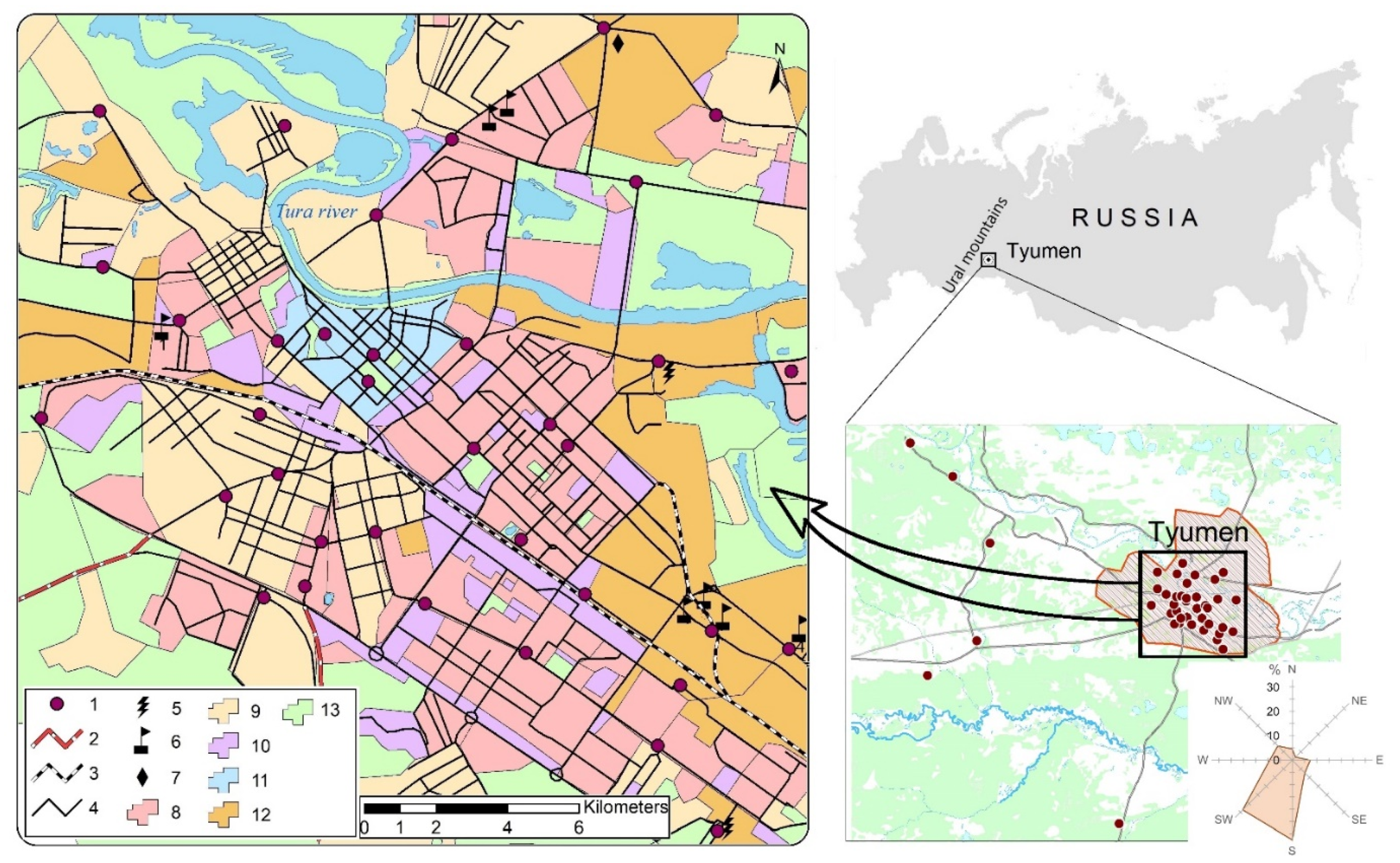
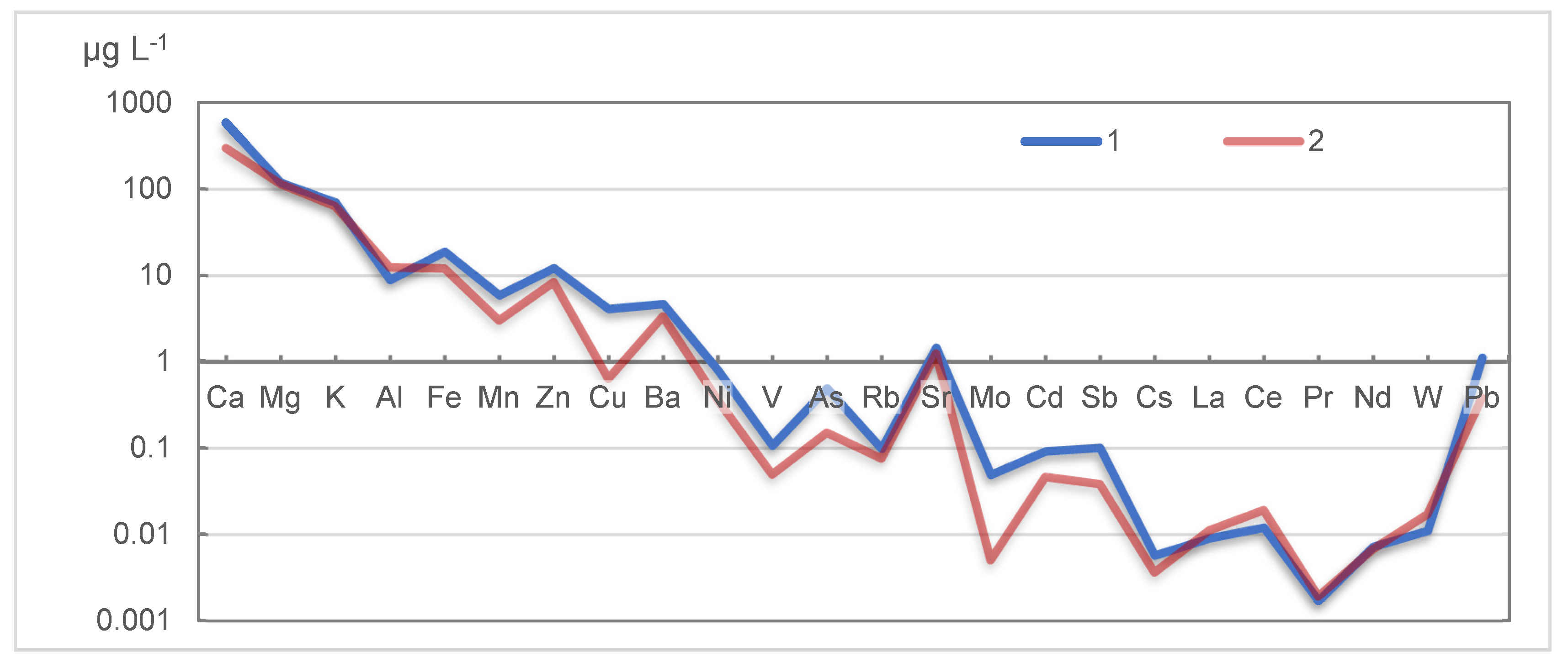
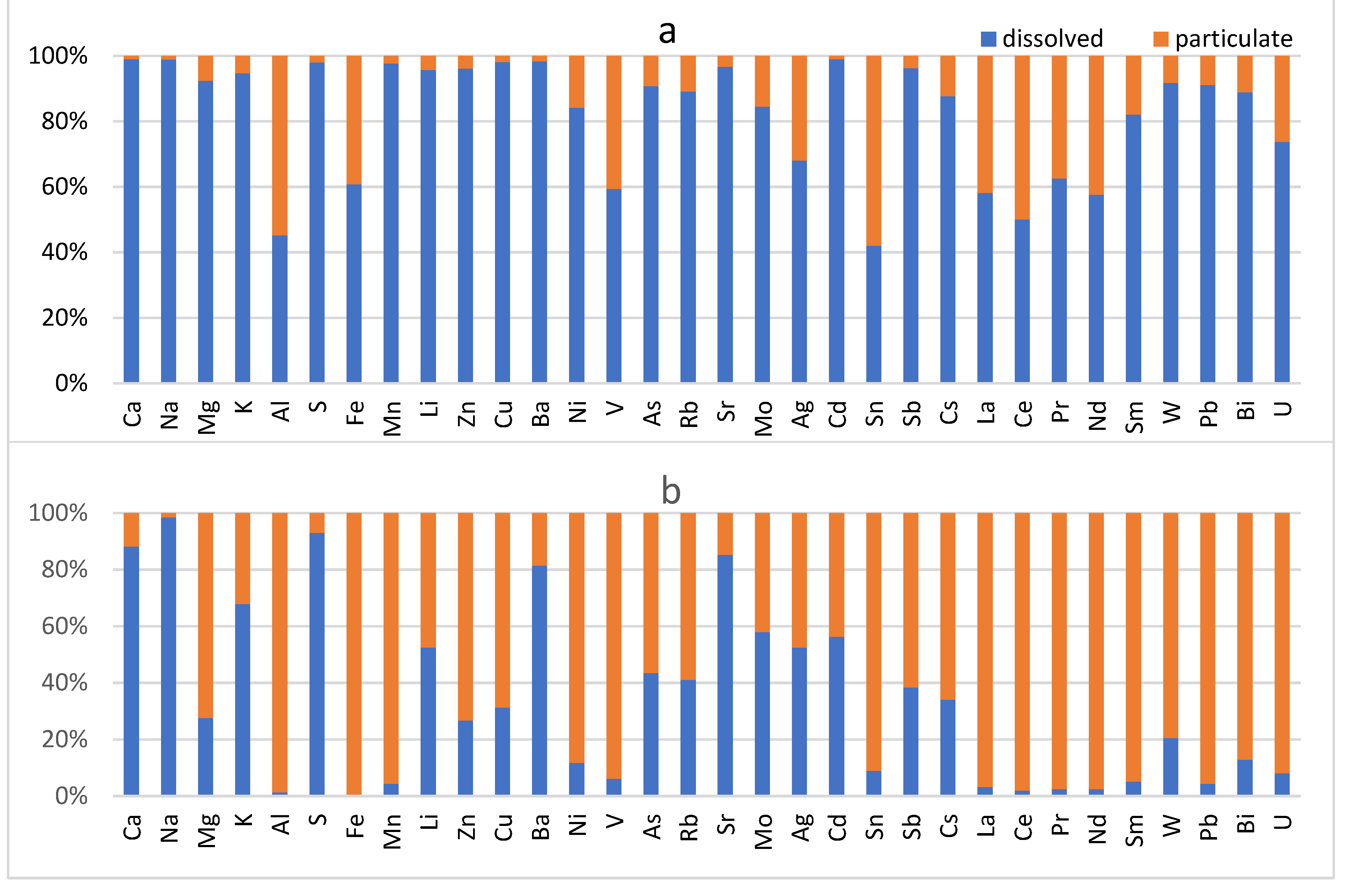
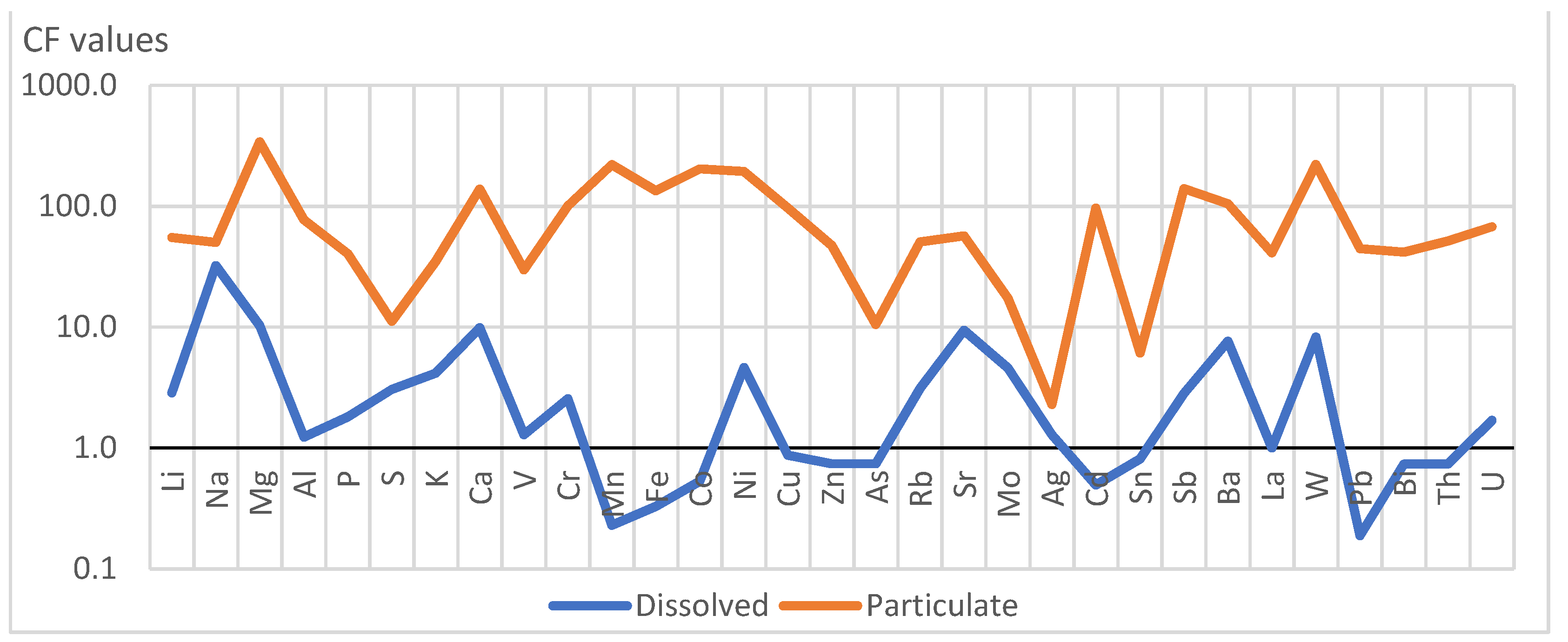
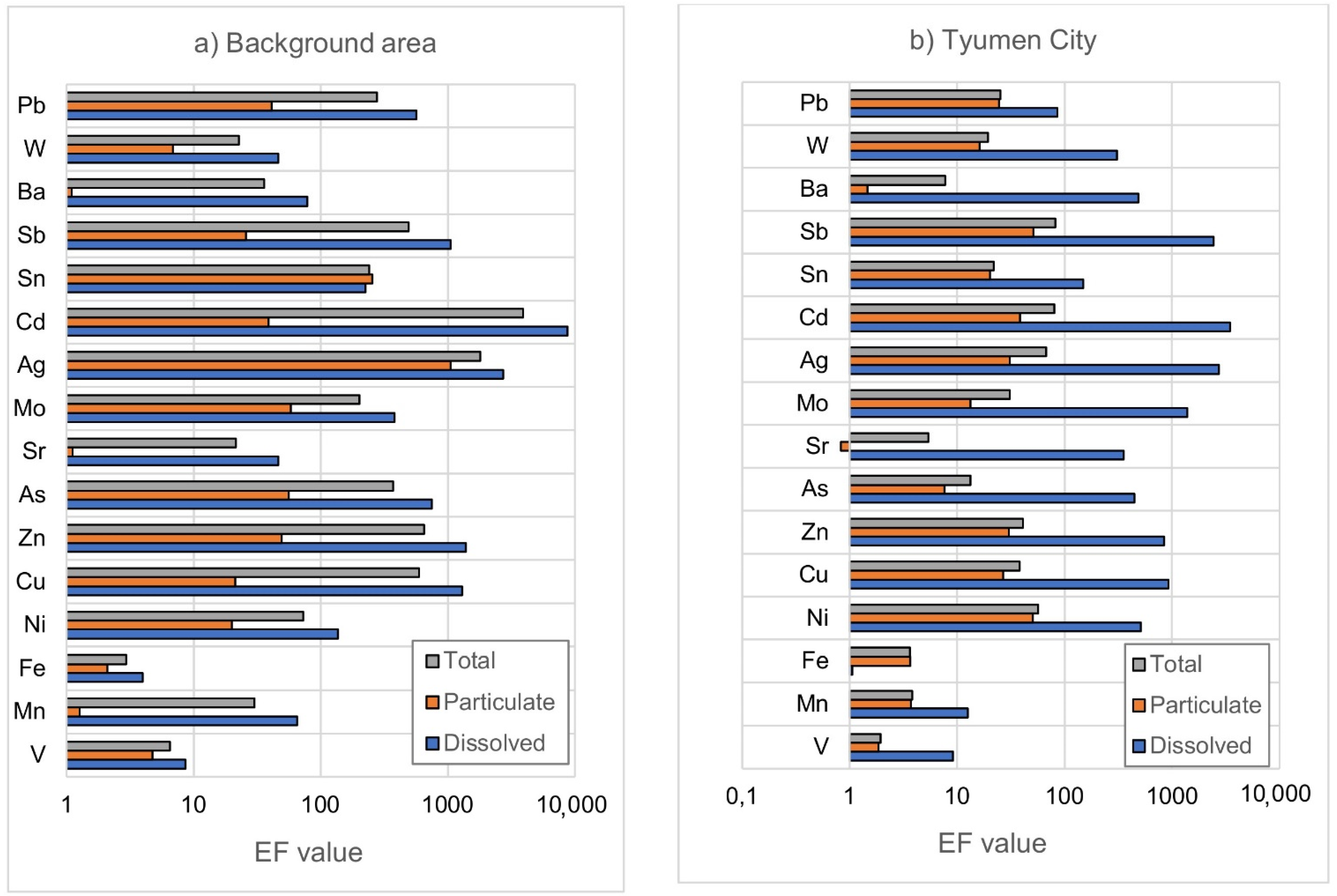
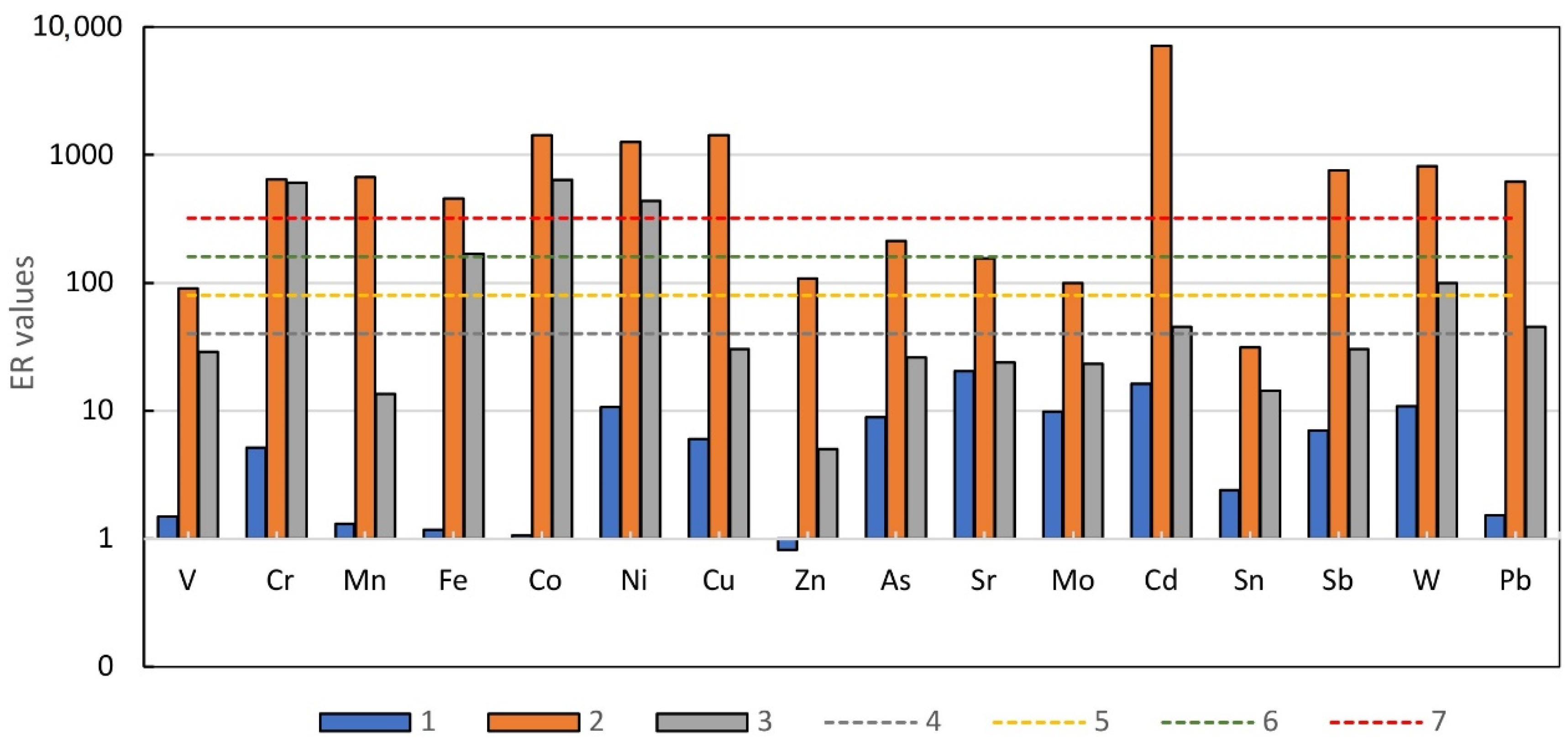

| Elements | Dissolved | Particulate | Total | PSE, % | ||||||
|---|---|---|---|---|---|---|---|---|---|---|
| DL | Mean | SD | Geometric Mean | DL | Mean | SD | Geometric Mean | |||
| Li | 0.007 | 0.14 | 0.095 | 0.11 | 0.0014 | 0.005 | 0.0029 | 0.005 | 0.12 | 95.7 |
| Na | 5 | 402 | 374 | 282 | 1.3 | 2.8 | 0.6 | 2.7 | 284.7 | 98.9 |
| Mg | 4 | 131 | 64 | 119 | 1.5 | 12.4 | 12.5 | 9.5 | 128.5 | 92.4 |
| Al | 1 | 10.2 | 4.9 | 8.9 | 0.9 | 11.7 | 5.4 | 10.9 | 19.8 | 45.2 |
| P | 16 | nd | 0.25 | 0.76 | 0.64 | 0.63 | 0.63 | nd | ||
| S | 15 | 355 | 68 | 350 | 1.5 | 7.2 | 0.5 | 7.1 | 357.1 | 98.0 |
| K | 5 | 72.3 | 18.7 | 70.3 | 0.9 | 4.1 | 1.1 | 3.9 | 74.2 | 94.7 |
| Ca | 6 | 595 | 135 | 581 | 2.5 | 5.6 | 0.3 | 5.6 | 586.6 | 99.0 |
| Ti | 0.8 | nd | 0.036 | 0.081 | 0.075 | 0.065 | 0.065 | nd | ||
| V | 0.07 | 0.152 | 0.088 | 0.11 | 0.025 | 0.086 | 0.055 | 0.072 | 0.18 | 59.4 |
| Cr | 0.6 | nd | 0.05 | 0.27 | 0.130 | 0.25 | 0.25 | nd | ||
| Mn | 0.07 | 7.3 | 6.17 | 5.89 | 0.05 | 0.15 | 0.073 | 0.14 | 6.04 | 97.6 |
| Fe | 4 | 20.2 | 7.53 | 18.9 | 3.0 | 14.0 | 9.48 | 12.2 | 31.1 | 60.8 |
| Co | 0.1 | nd | 0.003 | 0.009 | 0.006 | 0.008 | 0.008 | nd | ||
| Ni | 0.3 | 0.95 | 0.46 | 0.80 | 0.032 | 0.161 | 0.099 | 0.15 | 0.95 | 84.2 |
| Cu | 0.3 | 4.68 | 2.53 | 4.09 | 0.032 | 0.091 | 0.046 | 0.082 | 4.17 | 98.1 |
| Zn | 0.7 | 13.2 | 5.51 | 12.2 | 0.14 | 0.535 | 0.083 | 0.530 | 12.7 | 96.1 |
| As | 0.06 | 0.505 | 0.13 | 0.49 | 0.031 | 0.046 | 0.015 | 0.045 | 0.54 | 90.7 |
| Rb | 0.006 | 0.100 | 0.023 | 0.098 | 0.0023 | 0.009 | 0.005 | 0.008 | 0.11 | 89.1 |
| Sr | 0.08 | 1.505 | 0.37 | 1.46 | 0.014 | 0.044 | 0.010 | 0.043 | 1.51 | 96.7 |
| Y | 0.002 | 0.004 | 0.002 | 0.003 | 0.0005 | 0.004 | 0.002 | 0.004 | 0.007 | 42.9 |
| Zr | 0.004 | nd | 0.0005 | 0.032 | 0.012 | 0.030 | 0.030 | nd | ||
| Nb | 0.004 | nd | 0.0005 | 0.0044 | 0.0013 | 0.0042 | 0.0042 | nd | ||
| Mo | 0.008 | 0.051 | 0.016 | 0.049 | 0.0002 | 0.0094 | 0.0025 | 0.0092 | 0.058 | 84.5 |
| Ag | 0.004 | 0.022 | 0.016 | 0.017 | 0.0002 | 0.010 | 0.008 | 0.008 | 0.025 | 68.0 |
| Cd | 0.004 | 0.096 | 0.030 | 0.092 | 0.0004 | 0.001 | 0.002 | 0.001 | 0.093 | 99.0 |
| Sn | 0.008 | 0.076 | 0.043 | 0.066 | 0.0034 | 0.137 | 0.149 | 0.091 | 0.157 | 42.0 |
| Sb | 0.004 | 0.104 | 0.029 | 0.100 | 0.0015 | 0.003 | 0.001 | 0.003 | 0.104 | 96.2 |
| Cs | 7·10−4 | 0.0058 | 0.0015 | 0.0057 | 0.0004 | 0.0009 | 0.0004 | 0.0009 | 0.0065 | 87.7 |
| Ba | 0.05 | 3.20 | 1.15 | 4.69 | 0.005 | 0.08 | 0.04 | 0.08 | 4.77 | 98.3 |
| La | 0.003 | 0.0100 | 0.0050 | 0.0090 | 0.0003 | 0.0069 | 0.0027 | 0.0065 | 0.016 | 58.1 |
| Ce | 0.002 | 0.014 | 0.009 | 0.012 | 0.0003 | 0.013 | 0.005 | 0.012 | 0.024 | 50.0 |
| Pr | 4·10−4 | 0.0017 | 0.0010 | 0.0015 | 0.0003 | 0.0010 | 0.0005 | 0.0009 | 0.0024 | 62.5 |
| Nd | 0.002 | 0.0072 | 0.0026 | 0.0068 | 0.0003 | 0.0058 | 0.0037 | 0.0049 | 0.0118 | 57.6 |
| Sm | 9·10−4 | 0.0044 | 0.0042 | 0.0032 | 0.0005 | 0.0008 | 0.0005 | 0.0008 | 0.0039 | 82.1 |
| W | 0.003 | 0.012 | 0.007 | 0.011 | 0.0005 | 0.003 | 0.002 | 0.002 | 0.012 | 91.7 |
| Pb | 0.02 | 1.34 | 0.76 | 1.12 | 0.002 | 0.13 | 0.10 | 0.10 | 1.23 | 91.1 |
| Bi | 0.001 | 0.011 | 0.008 | 0.008 | 0.0003 | 0.0010 | 0.0004 | 0.0010 | 0.0090 | 88.9 |
| Th | 9·10−4 | 0.0019 | 0.0006 | 0.0019 | 0.0002 | 0.0011 | 0.0006 | 0.0010 | 0.0028 | 67.9 |
| U | 5·10−4 | 0.0015 | 0.0005 | 0.0014 | 0.0002 | 0.0005 | 0.0003 | 0.0004 | 0.0019 | 73.7 |
| Elements | Dissolved | Particulate | Total | PSE, % | ||||
|---|---|---|---|---|---|---|---|---|
| Mean | SD | Geometric Mean | Mean | SD | Geometric Mean | |||
| Li | 0.88 | 2.73 | 0.31 | 0.78 | 0.95 | 0.27 | 0.58 | 52.5 |
| Be | nd | 0.047 | 0.054 | 0.018 | 0.018 | nd | ||
| Na | 15612 | 24849 | 9115 | 375 | 458 | 136 | 9251 | 98.5 |
| Mg | 1473 | 867 | 1226 | 11608 | 15962 | 3219 | 4445 | 27.6 |
| Al | 14 | 9 | 11 | 2472 | 2937 | 836 | 847 | 1.3 |
| P | 19.7 | 19.2 | 14.5 | 82.4 | 156.6 | 25.7 | 40.2 | 36.1 |
| S | 1123 | 396 | 1070 | 187 | 231 | 80 | 1150 | 93.0 |
| K | 393 | 350 | 293 | 345 | 403 | 138 | 431 | 67.9 |
| Ca | 6674 | 4105 | 5753 | 2953 | 4348 | 777 | 6530 | 88.1 |
| Sc | nd | 1.11 | 1.44 | 0.33 | 0.33 | nd | ||
| Ti | nd | 184.7 | 260.6 | 54.0 | 54.0 | nd | ||
| V | 0.16 | 0.07 | 0.14 | 6.71 | 8.09 | 2.16 | 2.30 | 6.1 |
| Cr | nd | 81.2 | 109.8 | 24.7 | 24.7 | nd | ||
| Mn | 1.8 | 1.4 | 1.4 | 98.9 | 123.4 | 31.5 | 32.9 | 4.3 |
| Fe | 10.9 | 9.3 | 6.2 | 5728 | 7882 | 1638 | 1644 | 0.4 |
| Co | nd | 5.71 | 8.03 | 1.58 | 1.58 | nd | ||
| Ni | 4.3 | 2.5 | 3.7 | 93.4 | 129.9 | 27.8 | 31.5 | 11.7 |
| Cu | 4.9 | 3.6 | 3.6 | 24.2 | 37.1 | 8.0 | 11.6 | 31.3 |
| Zn | 10.0 | 4.0 | 9.1 | 59.1 | 70.6 | 25.0 | 34.1 | 26.7 |
| Ga | nd | 0.46 | 0.56 | 0.15 | 0.15 | nd | ||
| As | 0.44 | 0.18 | 0.36 | 1.04 | 1.15 | 0.47 | 0.83 | 43.4 |
| Rb | 0.37 | 0.30 | 0.30 | 1.13 | 1.34 | 0.42 | 0.72 | 41.1 |
| Sr | 30.0 | 74.5 | 13.8 | 6.95 | 9.08 | 2.5 | 16.3 | 85.2 |
| Y | nd | 0.62 | 0.79 | 0.21 | 0.21 | nd | ||
| Zr | nd | 4.36 | 5.66 | 1.52 | 1.52 | nd | ||
| Nb | nd | 0.39 | 0.52 | 0.14 | 0.14 | nd | ||
| Mo | 0.24 | 0.09 | 0.22 | 0.47 | 0.75 | 0.16 | 0.38 | 57.9 |
| Ag | 0.026 | 0.014 | 0.021 | 0.035 | 0.036 | 0.018 | 0.04 | 52.5 |
| Cd | 0.050 | 0.019 | 0.045 | 0.097 | 0.11 | 0.038 | 0.083 | 56.3 |
| Sn | 0.079 | 0.063 | 0.054 | 1.46 | 2.21 | 0.55 | 0.61 | 8.9 |
| Sb | 0.35 | 0.20 | 0.28 | 1.28 | 1.69 | 0.46 | 0.74 | 38.4 |
| Cs | 0.022 | 0.032 | 0.015 | 0.080 | 0.095 | 0.030 | 0.044 | 34.1 |
| Ba | 59.3 | 96.6 | 35.9 | 24.3 | 31.4 | 8.2 | 44.1 | 81.4 |
| La | 0.010 | 0.006 | 0.009 | 0.73 | 0.89 | 0.27 | 0.28 | 3.2 |
| Ce | 0.014 | 0.010 | 0.011 | 1.61 | 2.0 | 0.57 | 0.585 | 1.9 |
| Pr | 0.0015 | 0.0008 | 0.0013 | 0.15 | 0.18 | 0.052 | 0.053 | 2.5 |
| Nd | 0.0059 | 0.0033 | 0.0051 | 0.543 | 0.65 | 0.200 | 0.205 | 2.5 |
| Sm | 0.0026 | 0.0015 | 0.0022 | 0.11 | 0.135 | 0.040 | 0.043 | 5.1 |
| Gd | 0.0015 | 0.0004 | 0.0015 | 0.096 | 0.12 | 0.034 | 0.036 | 4.2 |
| Er | 0.0015 | 0.00024 | 0.00075 | 0.063 | 0.077 | 0.022 | 0.022 | 3.4 |
| W | 0.11 | 0.11 | 0.09 | 1.34 | 1.81 | 0.36 | 0.44 | 20.5 |
| Pb | 0.34 | 0.30 | 0.21 | 13.1 | 20.8 | 4.6 | 4.80 | 4.4 |
| Bi | 0.0081 | 0.0071 | 0.0059 | 0.11 | 0.16 | 0.040 | 0.046 | 12.8 |
| Th | 0.0014 | 0.0004 | 0.0014 | 0.13 | 0.15 | 0.050 | 0.052 | 2.7 |
| U | 0.0043 | 0.0091 | 0.0024 | 0.084 | 0.105 | 0.028 | 0.030 | 8.0 |
| City, Country, Location | Co | Ni | Cu | Zn | As | Cd | Pb | Mn | V | Reference |
|---|---|---|---|---|---|---|---|---|---|---|
| Tyumen, Russia dissolved | nd | 3.7 | 3.6 | 9.1 | 0.36 | 0.045 | 0.21 | 1.4 | 0.14 | This study |
| particulate | 1.58 | 27.8 | 8.0 | 25.0 | 0.47 | 0.038 | 4.6 | 31.5 | 2.16 | |
| total | 1.58 | 31.5 | 11.6 | 34.1 | 0.83 | 0.08 | 4.8 | 32.9 | 2.29 | |
| Moscow, traffic zones, dissolved | 0.28 | 4.6 | 5.2 | 16 | 0.05 | 0.068 | 0.35 | 11 | 0.92 | [67] |
| particulate | 1.6 | 6.1 | 1.7 | 33 | 0.27 | 0.053 | 5 | 55 | 12 | |
| total | 1.88 | 10.7 | 6.9 | 49 | 0.32 | 0.121 | 5.35 | 66 | 12.9 | |
| Vladivostok, Russia (total), city | - | 0.64 | 2.81 | 32 | - | 0.11 | 0.91 | 36.4 | 0.69 | [86] |
| suburb | - | 0.36 | 2.16 | 22.7 | - | 0.05 | 1.04 | 17.3 | 0.69 | |
| Lake Baikal and the adjacent territory(total) | 1.0 | 1.0 | 2.0 | 5.0 | - | 1.0 | 1.5 | 8.0 | 2.0 | [24] |
| Chernogolovka, Russia(total) | 4.1 | 7.8 | 5.8 | 240 | - | - | 7.2 | 141 | 16 | [87] |
| Svirsk, Russia (total) | 0.41 | 2.3 | 2.3 | 18 | 3.7 | 0.07 | 0.48 | - | 3.3 | [88] |
| Poznan, Poland (total) | - | 3.77 | 2.03 | 13.2 | 0.71 | 0.08 | 4.93 | - | - | [22] |
| Tianjin, China. 2015 year (total) | 0.17 | 1.25 | 1.96 | 22.1 | 1.37 | 0.66 | 0.17 | 13.6 | 0.34 | [89] |
| Luleo, Sweden, City Center, no-traffic area (total) | - | - | 14 | 50 | - | - | 16 | - | - | [68] |
Publisher’s Note: MDPI stays neutral with regard to jurisdictional claims in published maps and institutional affiliations. |
© 2021 by the authors. Licensee MDPI, Basel, Switzerland. This article is an open access article distributed under the terms and conditions of the Creative Commons Attribution (CC BY) license (https://creativecommons.org/licenses/by/4.0/).
Share and Cite
Moskovchenko, D.; Pozhitkov, R.; Zakharchenko, A.; Tigeev, A. Concentrations of Major and Trace Elements within the Snowpack of Tyumen, Russia. Minerals 2021, 11, 709. https://doi.org/10.3390/min11070709
Moskovchenko D, Pozhitkov R, Zakharchenko A, Tigeev A. Concentrations of Major and Trace Elements within the Snowpack of Tyumen, Russia. Minerals. 2021; 11(7):709. https://doi.org/10.3390/min11070709
Chicago/Turabian StyleMoskovchenko, Dmitriy, Roman Pozhitkov, Aleksandr Zakharchenko, and Aleksandr Tigeev. 2021. "Concentrations of Major and Trace Elements within the Snowpack of Tyumen, Russia" Minerals 11, no. 7: 709. https://doi.org/10.3390/min11070709
APA StyleMoskovchenko, D., Pozhitkov, R., Zakharchenko, A., & Tigeev, A. (2021). Concentrations of Major and Trace Elements within the Snowpack of Tyumen, Russia. Minerals, 11(7), 709. https://doi.org/10.3390/min11070709





